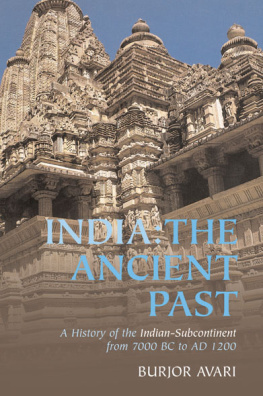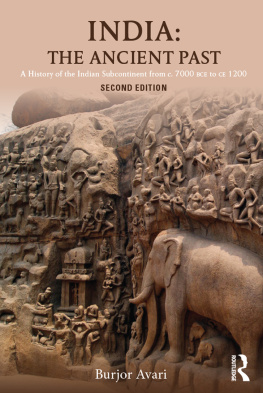Kavitha Mandana is the author of eight books for children published by Puffin (Penguin), Karadi Tales, Pratham and Red Turtle (Rupa). Her short fiction has appeared in various anthologies as well as in school English textbooks. Shes been writing and illustrating for the Deccan Heralds kids supplement for the past twenty years.

The Emperor
Who Vanished
Strange Facts from Indian History
Chapter 1
Apu and Nina sat across each other at a table in the library, in silence. They both had a dictionary open in front of them. Nina said, worriedly, Youre right, I guess. It says here that rusticate means to suspend from school or college.
Sssshhhhhhh, hissed the librarian from her desk behind the books for kindergarten section.
Apu stuck out his tongue and whispered, I told you so...and you thought Mathur Sir wanted us to learn about rustic life! Ha! What a joke!
Nina pretended not to care, but she so hated being proved wrong, by Apu in particular. Yet, she still found it difficult to believe anyone would want to rusticate themthey, the team that had just won the Best Social Studies Model prize. And only because silly Apu knocked over and broke that very same model. Didnt being rated Best count for anything? Even if that Best was now broken?
She said, I wish I wasnt always paired with you for Social Science projects. Its just my luck that both our surnames begin with R.
Youre acting as if this is my fault. It was your brilliant idea to make a real river model for the project, Apu hissed, careful not to attract the librarians wrath.
Yes, but it was you who clumsily knocked over our model and sloshed all that water across the room, ruining Sirs brand new shoes.
But if we hadnt had real water in our model, Sirs shoes wouldnt have got ruined when the model broke...I hope you realize that its ruined shoes thats landed us here, and not a broken model, Apu lashed out, almost forgetting to keep his voice low.
Resigned to their fate, the two put away the dictionaries and reluctantly settled down to some long hours of boring Social Studies research. Neither of them wanted to be suspended, so if Mathur Sir insisted on forty pages of research on the Ancient Structures of India, Nina and Apu decided theyd give him fifty pages, just to be safe.
They began with the Taj Mahal, certain they couldnt go wrong there. Apu swore that hed follow all of Sirs rules. Only relevant information, Sir had cautioned, well aware of how these two tiring children tended to go chasing information that was out of proportion, unnecessary or simply useless. All Sir wanted were the measurements, the materials used and which king built which structure.
Nina grumbled, Hell make us collect all this boring stuff and give us these facts itself for Fill in the Blanks in our next test. Pah!
Theyd searched for and got down all the boring details about the Taj, when Nina spotted a little box in the encyclopaedia shed opened. It was something about Delhi and Agra being in a seismically active zone. That was enough to set off the two fact-finding bloodhounds on a merry chase. Before they knew it, their half-page of boring facts on the Taj Mahal was dwarfed by the three pages they wrote on what Sir was JUST NOT INTERESTED IN!

The Taj Mahal is located in a high seismic zone, yet it has never been damaged by an earthquake

What is a high seismic zone?
The regions around Delhi and Agra in north India are in an earthquake-prone belt. On a scale where Zone 1 is considered safe and Zone 5 dangerous, Delhi and Agra are in Zone 4.
A number of massive earthquakes have struck the north of India and indeed the entire Himalayan belt over the centuries. In 1935, Quetta, now part of Pakistan, was hit by a huge earthquake. It flattened the city and killed over 10,000 people. At the eastern end of the Himalayan fault line, Assam has been hit by big earthquakes, most notably in 1897 and 1950, killing thousands.
In the century preceding the building of the Taj Mahal, a series of devastating earthquakes occurred across the Himalayan fault line. It began with a quake in Kashmir, in 1501. One month later, an earthquake hit what is todays Afghanistan. And in 1505, in the central Himalayas, another devastating earthquake hit. This could be felt within a radius of 500 miles from the epicentre. It destroyed monasteries in Tibet, north of the Himalayas, and tremors were felt as far south as Agra. This quake was so violent, it wiped out 30 per cent of Nepals population. Then decades later, the year before a teenaged Akbar became king, in 1555, Kashmir was rocked by another quake.
So how exactly has the Taj survived three and a half centuries without damage in the seismically active Zone 4?
What could have preserved the Taj?
Since historians havent quite agreed 100 per cent on who the architect of the Taj Mahal was, and because there are no architectural drawings of this great monument, we can only guess at how the monument has stood unshaken over the years.
For instance, historians do know that the four minarets have been specifically designed to lean away from the main structure. Soaring a majestic 138 feet each, the minarets have been built up from an octagonal base, and taper towards the top, where an eight-windowed chhatri is perched. There are winding stairs up to the top of each minaret (that are now closed to the public). Each minaret is off plumb (or off centre) to different extents, ranging from leaning 2 inches outwards, to 8 inches away. So if ever the tremors from earthquakes in the region get strong, causing the minarets to falltheyd fall away from the Taj, not damaging it in any way.
In Islamic architecture, the dome is considered the most perfect of earthly structures. But in a seismically active region, a large dome would also be the first to collapse, being the only part of the structure with its centre (also the highest point) not supported from below.
Shah Jahan, the reigning Mughal emperor, wished to build the Taj Mahal as a tribute to his beautiful wife Mumtaz Mahal. And so, to build the Tajs famous dome, he hired Ismail Afandi from Turkey. He was known across the region as an expert dome-builder and designer of hemispheres. He was already well regarded by the Ottoman rulers of Turkey. This choice would have been crucial to the Tajs longevity. Afandi came from a region that is (in) famous for devastating earthquakes that occur in tragic regularity. In 1268, Turkey had witnessed a quake in Anatolia that killed 60,000a disaster that was recorded and lamented for centuries. In 1509, a quake in Istanbul killed over 10,000. And in Afandis own lifetime there were two deadly quakes in Turkey, in 1667 and 1668. So Turkish builders, in particular, had developed considerable expertise in building quake-resistant monuments.
Of the thirty-seven members of Shah Jahans core team comprising engineers, turret builders, marble workers, etc. nearly all came from regions which regularly witnessed earthquakesPersia, Syria, Afghanistan, Turkey, etc. So it is probable that apart from the sheer beauty of the Taj, a key element of its design is that it is earthquake-proof to a certain extent.

Picture-perfect

Next page








![Keith Bain - Frommers India [2010]](/uploads/posts/book/43617/thumbs/keith-bain-frommer-s-india-2010.jpg)




